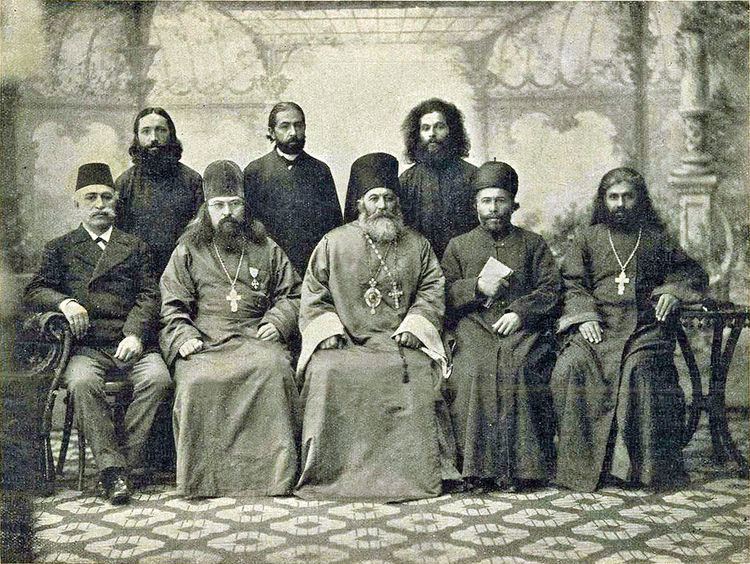 | ||
The Russian Ecclesiastical Mission in Urmia (Русская духовная миссия в Урмии, Orthodox Mission in Urmia, Урмийская духовная миссия) was an orthodox mission of the Russian Orthodox Church for ethnic Assyrians who lived in the border region with Russia in the Persian Azerbaijan province who converted from the Assyrian Church of the East and Chaldean Catholic Church in 1898. Other Assyrians in northern Iraq, northeast Syria and southeast Turkey had already long been members of the considerably older Syriac Orthodox Church. Formally, the mission covers only twenty years - from 1898 to 1918, but the period prior to its establishment, lasted almost the entire second half of the 19th century.
Contents
History
There was a group from the Assyrian Church of the East that converted to Orthodoxy in 1898. In the mid 1890s, Abun Mar Yonan, the Nestorian Bishop of Urmia, petitioned the Holy Synod of the Russian Orthodox Church that he and his flock be received into the Russian Church. Mar Yonan traveled to Saint Petersburg in 1898, where he and several of his clergy accepted Orthodoxy. They were received into the Russian Orthodox Church by confession of faith and vesting on the Feast of the Annunciation at the Holy Trinity Cathedral in Saint Alexander Nevsky Lavra. The services were presided over by Metropolitan Palladius (Raev) of Saint Petersburg. Also in 1898, the Holy Synod of the Russian Orthodox Church established the Russian Ecclesiastical Mission in Urmia, in order to aid Mar Yonan in the conversion and education of his flock.
Along with Bishop Yonan, Archimandrite Elia (Abraham) converted to Orthodoxy in 1898. In 1904 he was consecrated to the Episcopate and became vicar of Bishop Yonan.
Since 1905, the mission published the magazine Orthodox Urmia in both the Assyrian-Aramaic and Russian languages.
In 1918, renewed persecution by the Muslims resulted in a mass exodus of indigenous Christians (including Assyrians, Armenians and Georgians) from northern Persia. Over 100,000 Christians fled northern Persia heading south to Iraq; untold numbers were massacred along the way. The Orthodox Assyrians eventually ended up in Baghdad.
After the Russian Revolution, Bishop Elia could no longer communicate with Patriarch Tikhon in Moscow, and joined the Russian Orthodox Church Abroad.
Bishop Elia died in December 1928, and he was succeeded by Bishop John (Gewarigis) who was consecrated to the Epicopate in Belgrade in 1931 by Metropolitan Anthony (Khrapovitsky) and Archbishop Germogen (Maximov).
Bishop John resided in Baghdad where most of his flock lived. He retired due to old age in 1945, and eventually made his way to the U.S., where he lived with his son in Chicago. In the early 1950s, Bishop Nikon (Rklitsky), while visiting Chicago, "had a wonderful meeting with Bishop John of Urmia and Salma, the eldest member of our Council of Bishops, and spiritual head of the Orthodox Assyrians." Vladika Nikon noted that Bishop John spoke the same language as that spoken by Christ the Savior, and had been the translator at the Russian Ecclesiastical Mission in Urmia. After moving to Chicago to live in retirement, he found there were several thousand of his fellow Orthodox Assyrians, who were spiritually undernourished, living in the Chicago area. When Vladyka Nikon visited Bishop John, he found him "surrounded by Americans of Assyrian origin", to whom Bishop John was reading the Bible in their native language. The Synod of Bishops, through Archbishop Gregory (Borishkevitch) of Chicago and Cleveland (later of Chicago, Detroit and Midwest America), Protopresbyter Arkadii Tsepuro, Protopresbyter George Grabbe (later Bishop Gregory of Washington & Florida), and Protopresbyter Adrian Rymarenko (later Archbishop Andrew of Novo Diveyevo) arranged for Bishop John to live in retirement at the Novo Diveyevo Convent in Spring Valley, New York. He reposed at Novo Diveyevo in 1960 at the age of 105, and is buried in the cemetery located there.
